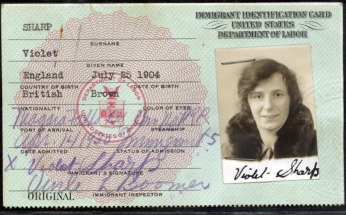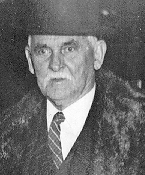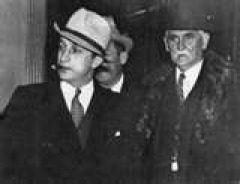Early Suspects
Violet Sharpe
Inspector Walsh, on loan to the New Jersey State Police from the Jersey City Police Department, agreed with Lieutenant Keaton, and clung to the idea that the kidnapping must have been an inside job. The peculiar circumstance of the kidnapper knowing both that the Lindberghs, contrary to their habit, were not returning to Englewood on Monday, and that the kidnappers knew precisely which room was the nursery, bothered Walsh.
Walsh was suspicious of Violet Sharpe, the twenty-eight-year-old maid at the Morrow estate. She knew of the change in the Lindberghs' plans. She was inconsistent in her accounting of her actions on the night of March 1, 1932, and clearly anxious and defensive. She was unable to identify the man she had gone to a roadhouse with the night of the kidnapping and she could not give the names of the other couple who accompanied them.
By June, Violet Sharpe had become so hysterical that Walsh and Schwarzkopf were sure they were on to something. They phoned that they would return to the Morrow estate for further questioning of Violet. Declaring that she couldn't stand it, she went upstairs and took cyanide, contained in a silver-polishing compound, and was dead within minutes.
Eventually, the man that Violet had been with, as well as the other couple, came forth to corroborate her story. She had been telling the truth, but could not admit to a "loose" behavior that might cost her her position at the Morrow estate. She was engaged to the butler, and this arrangement could have been jeopardized if it had been made known that she had been picked up and taken to a roadhouse for drinks. Schwarzkopf was roundly criticized for driving an innocent citizen to her death.
by Russell Aiuto
Eventually, the man that Violet had been with, as well as the other couple, came forth to corroborate her story. She had been telling the truth, but could not admit to a "loose" behavior that might cost her her position at the Morrow estate. She was engaged to the butler, and this arrangement could have been jeopardized if it had been made known that she had been picked up and taken to a roadhouse for drinks. Schwarzkopf was roundly criticized for driving an innocent citizen to her death.
by Russell Aiuto
Dr. John Condon
Walsh turned to the man who he considered to be the most suspicious: John F. Condon, "Jafsie," the do-gooder. Several days after Violet Sharpe's suicide, Condon was brought in for questioning. Despite hours of questioning, Condon gave as good as he got, and was released. During July and August, Schwarzkopf and his men tapped Condon's telephone, opened his mail, dug holes in his yard, and stripped the wallpaper of his study walls. During the next year and a half, undaunted by the suspicions hovering over him, Condon, reviewed thousands of mug shots, looking for "Cemetery John." A year after the kidnapping, in order to show his support, Lindbergh invited Condon and his daughter to dinner at the Morrow estate.
Shortly after that, Schwarzkopf and his men decided that Condon was eccentric, but not involved. The lone dissenter was Walsh, who then returned to his regular duties with the Jersey City Police Department.
by Russell Aiuto
Walsh turned to the man who he considered to be the most suspicious: John F. Condon, "Jafsie," the do-gooder. Several days after Violet Sharpe's suicide, Condon was brought in for questioning. Despite hours of questioning, Condon gave as good as he got, and was released. During July and August, Schwarzkopf and his men tapped Condon's telephone, opened his mail, dug holes in his yard, and stripped the wallpaper of his study walls. During the next year and a half, undaunted by the suspicions hovering over him, Condon, reviewed thousands of mug shots, looking for "Cemetery John." A year after the kidnapping, in order to show his support, Lindbergh invited Condon and his daughter to dinner at the Morrow estate.
Shortly after that, Schwarzkopf and his men decided that Condon was eccentric, but not involved. The lone dissenter was Walsh, who then returned to his regular duties with the Jersey City Police Department.
by Russell Aiuto
Thousands of Leads
In all, there were literally thousands of leads in all sections of the United States which were followed to their definite conclusions by the Bureau. The results of all these investigations, no matter how trivial, were reported. The activities of the known and suspected members of the so-called "Purple Gang" of Detroit, and various rumors and allegations concerning this gang were carefully and thoroughly investigated. Numerous registries of boats were examined in a fruitless endeavor to locate the boat "Nellie," on which the baby was to have been found according to the 13th and last ransom note handed to Dr. Condon at the time he paid the ransom money to "John." Records of cemetery employees who were employed in various cemeteries in certain sections of New York City and near Hopewell, New Jersey, were examined. Information accumulated in various other kidnapping and extortion cases handled by the FBI was examined in closest detail and studied with particular reference to any bearing they might have upon the solution of the Lindbergh case. Hundreds of photographs and descriptive data of known criminals of all types and other possible suspects were exhibited to the few eye-witnesses in this case in an endeavor to identify the mysterious "John."
On May 2, 1933, the Federal Reserve Bank of New York discovered 296 ten-dollar gold certificates, and one twenty- dollar gold certificate, all Lindbergh ransom notes. These bills were included among the currency received at the Federal Reserve Bank on May 1, 1933, and apparently had been made in one deposit. Immediately upon the discovery of these bills, deposit tickets at the Federal Reserve Bank for May 1, 1933, were examined. One was found bearing the name and address of "J.J. Faulkner, 537 West 149th Street," and had marked thereon "gold certificates," "$10 and $20" in the amount of $2,980. Despite extensive investigation, this depositor was never located.
by the Spirit of St. Louis 2 Project
® Copyright 1998-2007 CharlesLindbergh.com®, All rights reserved.




